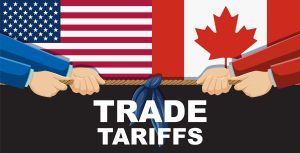Canada announces support for businesses affected by US tariffs

Anúncios
Canada announces support for businesses affected by US tariffs, offering a comprehensive financial relief program aimed at helping businesses navigate economic uncertainty.
This initiative provides grants, loans, and resources to ensure that Canadian businesses remain resilient amidst rising trade challenges.
Anúncios
For businesses feeling the impact of US tariffs, this support represents an opportunity to stabilize operations, manage costs, and continue growth even in a shifting trade landscape.
Impact of US tariffs on Canadian businesses
The imposition of US tariffs has created tangible challenges for Canadian businesses, affecting their operational costs, supply chains, and market strategies.
Anúncios
Many companies, particularly in manufacturing and export sectors, have reported noticeable increases in the cost of imported goods, forcing them to reconsider pricing, sourcing, and production methods to maintain competitiveness.
Understanding these effects is vital for companies navigating this evolving trade environment.
Rising Operational Costs and Pressure on Profitability
Tariffs on products imported from the US have directly increased the expenses associated with production and distribution.
Companies are experiencing higher costs for raw materials, components, and intermediate goods, which can have a ripple effect on the overall pricing structure. The consequences include:
- Higher consumer prices, as businesses attempt to pass on some of the increased costs.
- Narrower profit margins, forcing companies to find efficiencies or reduce expenditures elsewhere.
- Financial strain on small and medium-sized enterprises, which often lack the scale to absorb additional expenses.
In many cases, these increased costs require Canadian businesses to revise budgets, renegotiate contracts, or seek alternative suppliers to preserve financial stability and avoid disruptions to operations.
Disruption to Supply Chains
US tariffs have also caused significant supply chain challenges. Companies that rely on American suppliers for essential materials or components face delays and unpredictability, which can affect production schedules and inventory management.
Key impacts include:
- Delays in receiving critical goods, slowing manufacturing and delivery timelines.
- Reduced availability of high-demand products, which may limit sales or market responsiveness.
- Greater reliance on alternative suppliers, often requiring adjustments in logistics, sourcing agreements, or quality control measures.
Smaller companies are particularly vulnerable, as they typically have less negotiating power and fewer resources to adapt quickly.
For larger corporations, managing supply chain disruptions may involve complex contingency planning and strategic partnerships.
Broader Market Effects
Beyond immediate cost and supply issues, tariffs influence broader market dynamics. Companies may reconsider export strategies, pivot toward domestic sourcing, or adjust product offerings to remain viable.
The uncertainty caused by fluctuating trade policies often forces rapid decision-making, and businesses that fail to anticipate or respond effectively may lose competitive advantage.
In summary, the impact of US tariffs on Canadian businesses extends beyond simple price increases. It encompasses operational challenges, supply chain vulnerabilities, and strategic shifts in market planning.
Proactive adaptation, informed decision-making, and flexibility in sourcing and pricing are essential for companies seeking to sustain profitability and resilience in an unpredictable trade environment.
Details of Canada’s support package

Canada’s support package for companies affected by US tariffs is designed to provide targeted financial relief and promote long-term stability across key sectors.
The initiative focuses on helping enterprises manage immediate economic pressures while fostering resilience and adaptability in the face of ongoing trade uncertainties.
Understanding the scope of this package is essential for organizations seeking to maximize the benefits available.
Financial Assistance Options
A central component of the package is financial assistance, tailored to address both operational and strategic needs. The government offers multiple forms of support to ease the burden caused by tariffs:
- Interest-free loans to provide immediate liquidity, helping companies cover payroll, supplier payments, and other urgent expenses.
- Grants for operational costs, enabling enterprises to maintain essential functions without compromising financial stability.
- Industry-specific subsidies, designed to offset increased costs in sectors most impacted by tariffs, such as manufacturing and agriculture.
These measures allow companies to better manage cash flow and maintain operational continuity during challenging periods. Access to these resources can prevent financial disruption and support sustained activity in affected markets.
Focused Support for Small and Medium Enterprises
The package places special emphasis on small and medium-sized enterprises (SMEs), which often face greater vulnerability due to limited resources. Support for SMEs includes:
- Mentorship programs and educational workshops, helping owners navigate regulatory and market challenges effectively.
- Networking opportunities, connecting enterprises with peers and potential partners to share insights and strategies.
- Guidance on adapting operations, including advice on supply chain diversification and market expansion.
This holistic approach ensures that smaller enterprises have the knowledge and tools to remain competitive, even under the pressures imposed by tariffs.
Encouraging Innovation and Adaptation
Beyond immediate financial relief, the support package encourages companies to innovate and diversify.
By investing in new technologies, exploring alternative markets, or adjusting product offerings, enterprises can strengthen resilience and secure long-term sustainability.
Grants and incentives provided under this program allow companies to implement strategic changes that may have been otherwise unattainable, positioning them for success in a shifting economic landscape.
Ultimately, Canada’s support package aims to create a robust environment where companies can thrive despite the challenges of international trade.
By offering both financial backing and practical guidance, the initiative helps enterprises maintain operations, adapt strategies, and plan for sustainable growth across multiple sectors.
Eligibility criteria for businesses

Understanding the eligibility criteria for Canada’s support package is essential to ensure that assistance reaches the companies most affected by US tariffs.
The program prioritizes businesses that show a real economic impact, helping stabilize operations and protect employment.
Types of Businesses Eligible
Support is primarily aimed at small and medium-sized enterprises, which often face greater challenges adapting to trade disruptions.
Eligible businesses include manufacturers relying on US imports, service providers connected to impacted industries, and exporters facing difficulties in international markets due to tariff pressures.
These sectors are critical to the Canadian economy, and ensuring their stability helps maintain broader economic resilience.
Financial and Operational Requirements
Companies must demonstrate tangible impacts from tariffs to qualify.
This typically involves providing evidence of revenue decline linked to US tariffs, financial statements showing prior operational viability, and documentation of increased costs affecting day-to-day operations.
Meeting these requirements allows the government to allocate resources efficiently and ensures that support goes to businesses with genuine need.
Operational History and Compliance
Eligibility also considers the company’s operational history and adherence to regulations.
Businesses are usually required to have been active for at least one year and maintain compliance with relevant laws, ensuring that government aid supports responsible enterprises.
By targeting businesses with a proven track record, the program promotes sustainable growth and long-term resilience in sectors affected by trade challenges.
By understanding these criteria, companies can take the necessary steps to access support effectively and navigate the uncertainties caused by US tariffs.
Clear eligibility standards help ensure that aid strengthens the economy while supporting those most in need.
How to apply for the support
Accessing Canada’s support package is a straightforward process, but preparation is key. Businesses affected by US tariffs should gather all necessary documentation before starting the application to ensure a smooth experience.
Preparing Required Documents
Applicants need to provide proof of business registration and operational status, along with financial statements that clearly demonstrate the impact of tariffs on revenue and expenses.
Including details of the specific support being requested helps the authorities assess the level of assistance required.
Completing the Application
The application itself is submitted through the official online portal, designed for ease of use. Applicants should accurately report information about business size, industry, and recent changes in revenue caused by tariffs.
Clear and precise details allow for a faster review and reduce the risk of delays in processing.
After Submission
Once submitted, businesses receive a confirmation indicating that the application is being processed. Authorities may request additional information to clarify certain points, so staying proactive is important.
Approved applicants are then notified about funding disbursement, including how and when support will be provided, enabling companies to manage their finances effectively during this period of economic uncertainty.
By following these steps carefully, companies can maximize their chances of accessing the aid they need to overcome tariff-related challenges.
A well-prepared application ensures timely support and helps businesses maintain operational stability.
Future implications of trade relations

The evolving trade relationship between Canada and the US has long-term consequences for businesses across multiple sectors.
Understanding these implications is crucial for companies planning strategies, managing costs, and exploring growth opportunities.
Potential Long-term Effects
Ongoing tariffs can create ripple effects throughout the economy. Canadian companies may face higher import costs, limited access to certain US markets, and shifts in consumer behavior as customers seek alternative products.
These changes can influence operational planning, pricing strategies, and even decisions about market expansion. Companies that proactively adapt to these shifts are more likely to maintain profitability and competitiveness.
Opportunities for Diversification
Despite these challenges, altered trade dynamics present new avenues for growth. Canadian businesses are increasingly exploring partnerships outside North America and entering emerging markets.
Innovation and diversification, such as adopting new technologies or expanding product lines, can help offset the impact of tariffs.
Additionally, collaborating with domestic suppliers reduces dependency on US imports and strengthens supply chain resilience.
Strategic Adaptation
Businesses that embrace flexibility are better positioned for success. Investing in automation, improving efficiency, and reassessing sourcing strategies can help companies navigate trade uncertainties.
By staying informed about policy changes and global economic trends, businesses can anticipate challenges and seize opportunities that arise from shifting trade relations.
Sector-specific Impacts
Some industries may experience more pronounced effects than others.
Manufacturing, agriculture, and technology sectors, for instance, could face higher operational costs but may also benefit from new trade agreements or incentives designed to support affected industries.
Understanding sector-specific dynamics allows businesses to tailor strategies and remain competitive in an evolving landscape.
In conclusion, while trade relations with the US continue to present challenges, they also encourage Canadian businesses to innovate, diversify, and strengthen their resilience.
Companies that actively plan for these future scenarios will be better equipped to thrive in a changing global market.
Conclusion
Canada’s announcement of support for businesses affected by US tariffs represents a crucial opportunity for companies to stabilize and strengthen their operations during uncertain trade conditions.
By providing grants, interest-free loans, and subsidies, the government helps Canadian businesses manage costs, handle supply chain challenges, and stay competitive.
For small and medium-sized businesses, this support also encourages innovation and market diversification, allowing them to invest in new technologies, explore alternative suppliers, and expand into emerging markets.
Companies that proactively leverage these resources are better positioned to adapt to future trade fluctuations and build long-term resilience.
To fully understand the scope of the support, Canadian businesses can consult the official government announcement for detailed information on eligibility and application processes.
Additional insights and updates on how these measures are being implemented can be found through Niagara Canada’s coverage, helping companies make informed decisions and maximize the benefits of the program.
By staying informed and taking advantage of these support initiatives, Canadian businesses can not only survive the current challenges but also emerge stronger, more innovative, and strategically prepared for the future of international trade.
FAQ – Frequently Asked Questions about Canada’s Support for Businesses
What types of businesses are eligible for support?
Eligible businesses include small and medium-sized enterprises, especially those affected by US tariffs, such as manufacturers and service providers.
How can I apply for the support package?
To apply, gather the necessary documents, visit the official website, and complete the online application form.
What financial assistance is available?
The support package offers interest-free loans, grants for operational costs, and subsidies for affected industries.
What are the future implications of trade relations?
Future trade relations may lead to new trade agreements or shifts in market dynamics, requiring businesses to adapt their strategies.
Liked the article?





